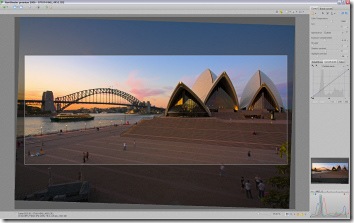It is no secret that I love the panorama format, I’ve mentioned this in countless posts. Read this one for why I love the wide format. I don’t own an actual panorama camera like a 6x17cm Linhof or 2x35mm Hasselblad x-pan so I shoot panoramas in two ways with my Canon 5D. The first way is to use an ultrawide lens, compose the photo as a panorama and then crop the top and bottom of the raw file in post production. The second way is digital stitching, shoot several photos and stitch them in programs like PTgui. This post focuses on cropped panoramas, the next post will focus on stitching.
Cropped panoramas
It’s simple as…just crop your photo so the width to height ratio is at least 2:1 and you have a wide panorama shot! If you want a good result there’s a bit more to it though. Have a look at these panoramas from Sydney and Perth (click to see large):
A sunset panorama view of the Opera House, The Harbour Bridge and a ferry.
A late afternoon view of Kings Park, gum trees, bicycle and person on the left, the skyline of Perth in the top right 1/3 and long shadows leading your eye into the shot.
Both shots are shot very wide with my 17-40mm L f/4.0 lens (which is super wide on a full frame Canon 5D) and then cropped as I developed the raw file. The next two screenshots from Rawshooter Premium shows you the full photos with the crop mask in place:


Notice how the Sydney shot needs almost every bit of the 17mm wide view to get everything in frame. Also notice how much dead space I have in the top and bottom of the shots? That’s intentional of course, I composed with a cropped pano in mind so the full shots are boring compositions with far too much dead space and the horizon dead in the middle – which leads us to:
Composing the cropped panoramas
Here is what I do:
- Shoot at around 17mm on my full frame Canon 5D so I can get a very wide shot (equivalent to around 10mm on a crop DSLR camera)
- Look through the viewfinder and visualize the 3:2 image as a cropped panorama at least 2:1 wide – this is the hard part, you have to compose the shot inside a panorama rectangle you don’t have in your viewfinder, only in your head.
- Stick the horizon straight in the middle of the viewfinder (the actual viewfinder, not your imaginary pano viewfinder). I’m cropping the shot anyway later and having the horizon in the middle of the original shot greatly reduces the barrel distortion at 17mm.
- Make sure you get plenty of dead space top and bottom of the shot and look carefully in all corners of your viewfinder to make sure you have your panorama composition inside your imaginary panorama viewfinder.
- Shoot 4-5 slightly different versions to make sure you have one useable for cropping.
The hard part is visualising your panorama composition inside a 3:2 viewfinder, sometimes I use my hands to form a pano viewfinder (film director style) and sometimes I wonder if I should carry a piece of cardboard cutout as a pano viewfinder. If anyone owns an old Panavision viewfinder they’d love to sell me get in touch! 😀
Cropping the photo in post production
This is the good part about shooting cropped panos, it opens possibilities in post productions. You might not end up with what you imagined when you shot it (you might not even remember what you imagined) but you have lot’s of options since your shot has so much dead space. Remember to crop this dead space though and crop it tight, you want to create a photo with an exciting panorama composition that creates visual tension for your viewer.
Conclusion
I find this method of shooting cropped panos works very well after some practice. If you intend to sell these cropped files or print them at large sizes you need lots of pixels though since you’re cropping away so many of the pixels. I have 13 megapixels of high quality in my Canon 5D and that’s alright, poster prints at 100dpi at 120cm wide look great. I could use more though and some day I might invest in the new Canon 1Ds MkIII camera with it’s amazing 21 megapixel full frame sensor.
Next time I’ll talk about stitched panoramas but until then, if you like panoramas as much as me – get out there and practice shooting cropped panos, it’s great fun!


